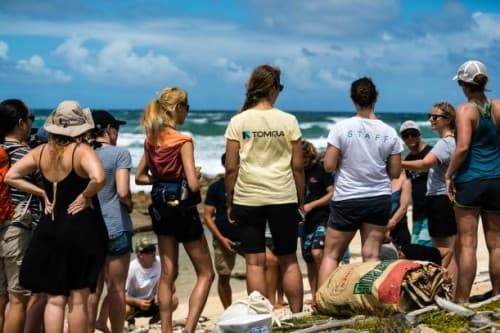Turning off the tap for rising marine litter
A million plastic bottles are sold every minute. TOMRA has made it its mission to stop them reaching the ocean.

The numbers are overwhelming, over eight million tons of plastic waste are ending up in our oceans every year, every square kilometer of the deep sea contains over four billion plastic microfibers and over 269,000 tons of plastic waste is visibly floating on the surface of the water.
The magnitude of this problem is further highlighted by the finding of a plastic bag at the bottom of the Mariana Trench – the ocean’s deepest point at 36,000ft.
Although some of the waste can be attributed to fishing equipment discarded at sea, or littering on beaches, the vast majority of this staggering volume of waste originates on land. Wind and rain create pathways for plastic into rivers and streams where it eventually gets carried into our oceans. The short message is – in order for us to stop the flow of plastic into the sea, we need to turn the tap off on land.
Analysis of types of marine litter has shown us that the vast majority of plastic waste is single-use, including bags, straws, plastic cutlery and containers, but most importantly to resource sustainability company TOMRA, plastic bottles are high on the list of guilty culprits.
TOMRA are the global leaders in reverse vending, through their 80,000 reverse vending machines in over 60 markets, they collect 40 billion drinks containers for recycling, saving these bottles and cans from ending up as litter or in landfills. Although the world is waking up to the plastic pollution problem and governments are implementing more efficient recycling schemes, there is still much to be done.
Every minute a million plastic bottles are bought around the world and this number is expected to rise by 20% by 2021. The production of virgin plastic is growing – and this is an area TOMRA is challenging.
When a bottle is returned to a reverse vending machine for a recycling, the material is protected from contamination from other types of household waste, this means that the material quality can be maintained – ensuring a plastic bottle can turn back into another plastic bottle in a never-ending ‘closed loop.’
For every plastic bottle that is recycled and reused, there is an estimated up to 70 per cent reduction in carbon dioxide and other harmful gases, when compared to manufacturing bottles from virgin plastics. But equally, when a bottle can be reused for its intended purpose, one less bottle needs to be produced from virgin plastic, and one more bottle is saved from potentially ending up in our oceans – a double good deed.
The growing magnitude of marine litter is one of the biggest environmental catastrophes of our time and there is no one answer to the problem. Significant improvement will come from a series of solutions tackling the issue from all angles. However, ensuring plastic has a value will help ensure it is treated as a resource that can be used again and again. More material kept in a closed loop means less can escape into our oceans –in this case we could all do with being a bit more closed-minded.
